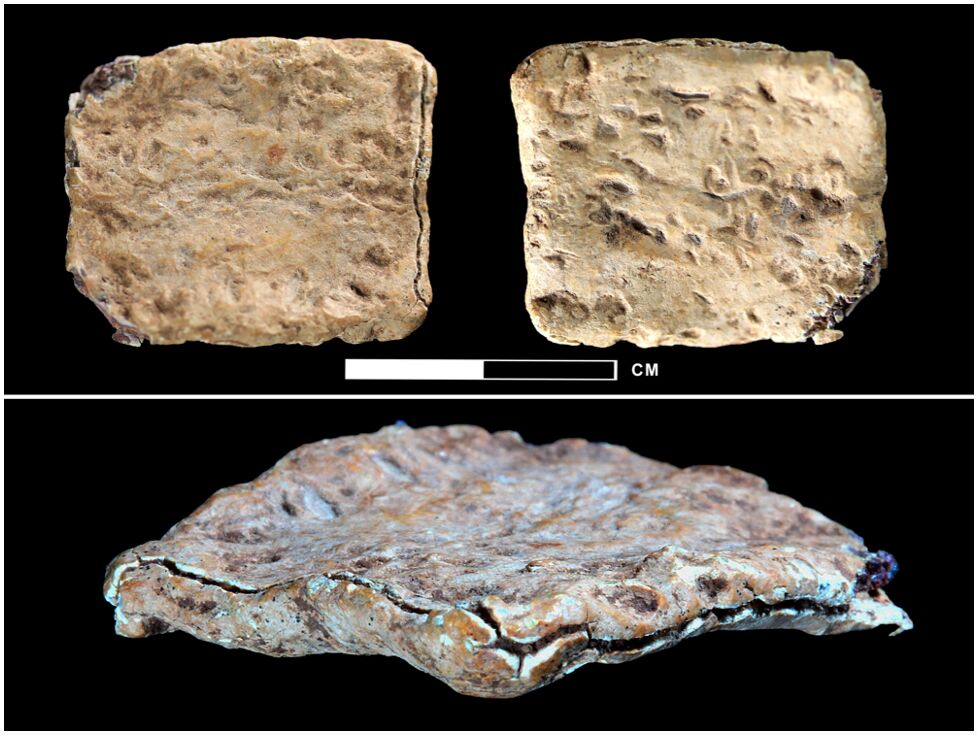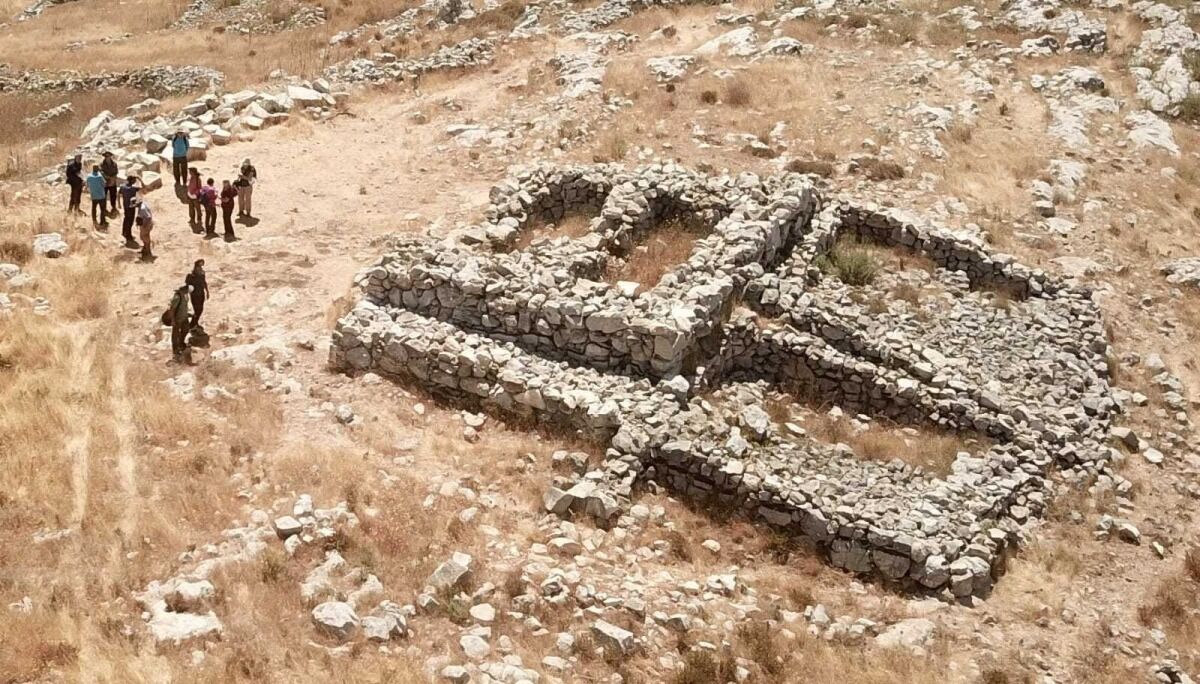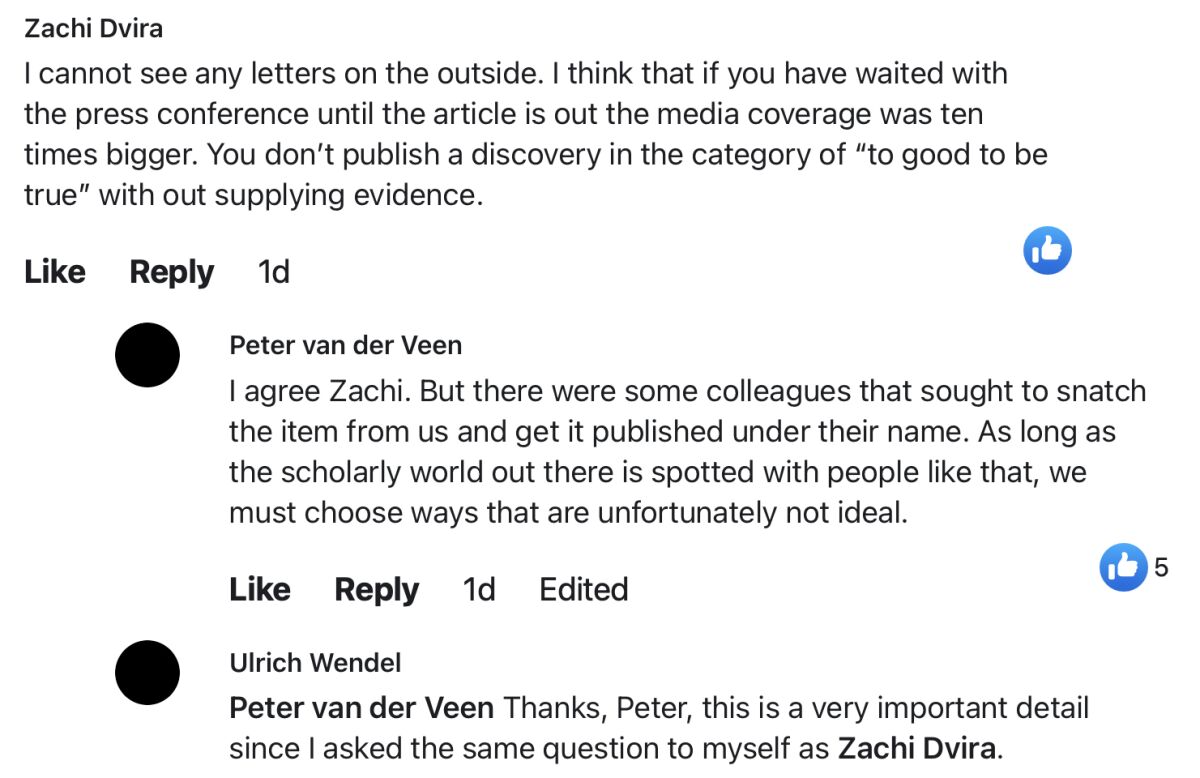“Drat. How did an ancient curse written in proto-Canaanite, found on Mount Ebal in the West Bank, wind up with evangelicals in Houston, Texas?”
So wrote one of Haaretz’s lead archaeology correspondents in an email to subscribers following the discovery of an inscription from Mount Ebal by Dr. Scott Stripling’s Associates of Biblical Research (abr) crew. For any potentially revolutionary artifact, especially for one purported to affirm especially early biblical accounts, there is guaranteed to be pushback.
This statement, with a dose of religious discrimination (imagine if a discovery were condemned for winding up with Jews), summarizes the building blowback against a discovery that the researchers assert is remarkable evidence of the historicity of the early biblical account.
A description of the discovery itself can be found here. To summarize, in a press release on March 24, the discovery of a small lead curse amulet, or defixio, was announced; the folded lead tablet was found by the abr team while wet-sifting the excavation dumps of the late Prof. Adam Zertal’s site on Mount Ebal, a ritual site identified as “Joshua’s Altar.” According to the release, the researchers, including epigraphers Pieter Gert van der Veen and Gershon Galil, announced the decipherment of some 40 letters in proto-alphabetic script within the folded lead item (as revealed by tomographic scans), translated as follows: “Cursed, cursed, cursed—cursed by the God [El] yhw. You will die cursed. Cursed you will surely die. Cursed by yhw—cursed, cursed, cursed.”

This inscription, together with the dating of the altar site to the Late Bronze ii period, dramatically parallels the biblical account of Joshua’s building an altar on the “mountain of curse,” Mount Ebal, and the blessings and curses ritual that took place at the site at that time (Deuteronomy 11 and 27; Joshua 8). The amulet is also notable not only as one of the earliest inscriptions found in the Holy Land, but also as the earliest such mention of the name Yahweh.
But “dramatic” discoveries are anathema to modern scholarship. As Prof. Israel Finkelstein summarized: “In general, I get annoyed by claims about discoveries that supposedly change everything we know about the Bible and the early history of Israel in one fell swoop.”
Finkelstein was quoted, alongside various other critics of the discovery, by another Haaretz journalist, Anshel Pfeffer, in a lengthy article less-than-subtly titled “From West Bank Debris to Evangelical Hands: The Shady Journey of a Bible-Era Curse.”
“As of now, just over a week after the dramatic press conference in Texas, it’s hard to say the archaeology world seems to share [the team’s] enthusiasm,” Pfeffer writes. He asserts that this is because the find simply cannot corroborate the biblical account. “[T]he events described in the Bible regarding Mount Ebal were written about hundreds of years after they took place, if they even did occur—therefore, any attempt to connect the events with the findings at the site are doomed to failure” (emphasis added).
Among the charges highlighted in the article are claims that the tablet was illegally excavated from a West Bank area, and that it was illegally removed from Israel for study in Prague. It includes a philosophical debate questioning “the difference between archaeologists and antiquities looters” and ponders over who West Bank discoveries really belong to anyway. Questions range from whether the Mount Ebal “altar” is really an altar at all to whether it really dates to the time Zertal claimed. And, of course, there is the notion that too much emphasis is placed on such artifacts when the focus should be placed instead on the plight of the Palestinians.
“[I]t’s a group of evangelicals that are not interested in findings and science, they are looking only for things designed to confirm and illustrate known history, that is part of a missionary process of messianic prophecies,” Alon Arad, ceo of Emek Shaveh, was quoted in the article as saying. Arad described the team as conducting a “pirate dig” that should be “treated accordingly.” (According to its site, Emek Shaveh is an “Israeli ngo working to prevent the politicization of archaeology in the context of the Israeli-Palestinian conflict.”) A senior official from the Palestinian Ministry of Tourism and Antiquities was also cited: “We condemn this activity, which was done in violation of international law.” (Ironically, the Mount Ebal site made headlines a year ago, after being partially demolished during Palestinian roadworks.) The allegations, particularly those relating to illegal activity, have been strongly denied by the team that uncovered the tablet.

A similarly negative view of the discovery was presented in a Biblical Archaeology Society (bas) article titled “An Early Israelite Curse Inscription from Mt. Ebal?” “Questions abound,” the article states, “and some scholars have expressed serious doubts about the team’s sensational claims, while other observers have pointed out the problematic circumstances surrounding its recovery.” The article is essentially a condensed version of Haaretz’s, highlighting the same “problems of provenance.”
[A]n investigation by Haaretz found that the abr team failed to get permission for the Mt. Ebal sifting project … calling into question the legality of the project and the find. Additionally, the abr team did not receive an export license to take the tablet out of the country for analysis, as is required by Israeli law.
Again, allegations of criminal activity that are denied by the researchers. Revealingly, however, at the end of the bas article, an editor’s note was included: “Christopher Rollston is a member of the Editorial Advisory Board of Biblical Archaeology Review” (part of the bas organization). Rollston, himself an epigrapher who was quoted throughout the bas piece, has written at some length disputing the discovery. Difficulties he sees with the discovery include: how the length of translated text could only consist of the 40 letters claimed; that the artifact was not found in stratified context; that the team did not carbon-date the sifted remains; that “people such as I have argued for some time that there was a fair amount of alphabetic writing in the late second millennium b.c.e” anyway; and that there is doubt about the Mount Ebal “altar” being an altar at all. (More on that subject can be read in our article here.)
Rollston was also quoted by Haaretz, stating this about the deity-name “yhw” in the inscription: “I don’t believe this word is really there, and even if it is, it doesn’t have to be the name of God but could be a verb. Cautiously, I think it could be a far later finding than what they’re proposing.”
“It’s a recurring pattern,” he says. “Researchers make huge declarations about the dramatic importance of their finding and then discover that it’s actually nice but not so dramatic. That happens again and again—especially when they hold a press conference before there’s an article that has undergone peer review.”
Actually, that is the point at the crux of the debate surrounding the discovery: It was released to the public before the publication of the detailed peer-reviewed article. No experts, besides the team directly studying the artifact, have yet seen the images of the text contained within the folded lead tablet, besides that shown at the conference (a drawn representation of the letters of the deity name, “yhw.”) Thus, the existing outside discussion and debate about the nature of the inscription is, for now, entirely conjectural.
This is something that would clear up much of the debate, doubt, alternate theories and skepticism flowering around the discovery: the full, published report, including the official images of the artifact, the drawings, the closeups and the complete, letter-for-letter translation. As Rollston states on his site: “[S]ensational claims require sensational evidence …. [A]t the press conference *no* images from the Academy of Sciences of the Czeck [sic] Republic were shown. Thus, claims were made, but the real evidence was not shown!”
I wholeheartedly agree. Sensational claims do require sensational evidence. Yet largely missing from the general firestorm has been the simple question: Why was the discovery publicized before the peer-reviewed article was published, and with such minimal illustrative material of the artifact?
Actually, the original plan was for the full, peer-reviewed report to be out at the same time as the press release. Our institute had a general prior knowledge of this discovery coming down the pipeline, and we were settling in for the six-month wait until the end of summer, when the discovery would be made public alongside the peer-reviewed article.
Suddenly, in late March we were contacted with the news that there had been a change of plans—the press release would occur later that week. What had happened?
The answer was highlighted by one of the epigraphers, Dr. van der Veen, in the following Facebook comment:

This would explain the sudden shift in the date of the press release. (Also, the negative nature of this charge could explain why the reason for the early announcement wasn’t highlighted at the press release.) Still, the researchers have voiced their intention to get the official peer-reviewed piece out as soon as possible—ahead of the original schedule, if possible.
Until that time, though, we’ll just have to sit tight and wait. As another epigrapher, Dr. Haggai Misgav, aptly put it in his own Facebook post at the time of the press release (translated from Hebrew): “Before my email inbox crashes, I’m putting out this message for everyone. I haven’t seen pictures of the find …. Whatever I don’t see with my own eyes—as a researcher—I don’t have anything to say. Nothing about the find, nothing about the reading, nothing about its interpretation. Research requires responsibility; not to assert what is uncertain, certainly not to say what you don’t know, and not to come out immediately in dismissal.”
Certain aspects and claims of the discovery may or may not stand up to scrutiny. We’ll see in time. But we can only wait for the report and suspend judgment until then. As the proverb goes, “He that answereth a matter before he heareth it, it is folly and shame unto him” (Proverbs 18:13; King James Version).
And to this end, a comment from a reader of the above-mentioned bas article summed it up well:
I have been following this development. To say “scholars remain skeptical” is a mischaracterization. Some scholars remain skeptical. Others are hopeful. Still others choose to withhold judgment until the peer-reviewed articles are published. Your article seems to prejudge the matter without showing both sides. You state Stripling’s claims, but do not give his reasoning. You only give reasons for doubting his claims. I am a new subscriber to bas. I was expecting to read a fair review of this find, including reasons for and against accepting Stripling’s claims. I am disappointed.
She’s right, I think. There is an air of negativity around the discovery amplified by some scholars and journalists, based on unknowns. Yet this is hardly representative of scholarship in general, and certainly not of the wider public, who it’s safe to say have been enthralled by the discovery—whose knee-jerk reaction has certainly not been “Drat.”
And with all of the strife occurring in Israel and around the world right now, with some of the bloodiest weeks we have witnessed in recent history here and abroad, can’t we take a breath to celebrate some encouraging news about the promise of a very exciting discovery in the world of biblical archaeology—or at the very least, suspend judgment until the full release comes out?

